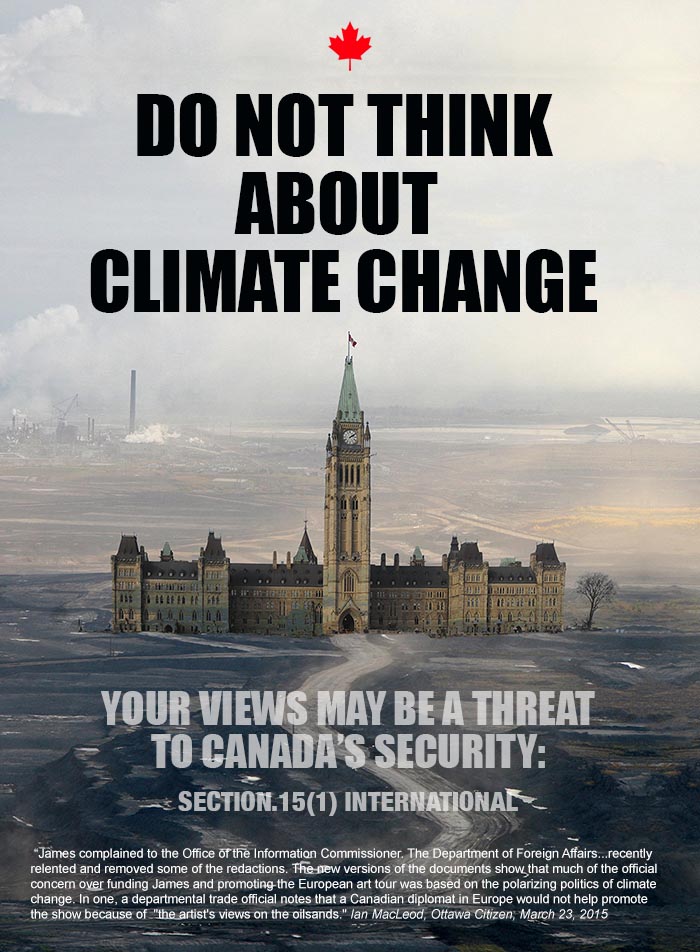
by Franke James, reposted from FrankeJames.com on Mar 30, 2015
I would have said you were crazy, and flat-out bonkers if you had told me 4 years ago that the Department of Foreign Affairs (DFAIT) would be claiming that there would be ‘injury to the conduct of Canada’s international affairs’ if their past discussions about me and my art show were revealed. (Canada initially agreed to kick in $5k under the UNFCCC agreement to provide climate change education for the corporate-sponsored art show.)
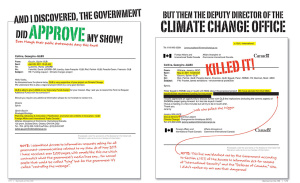 But in fact it’s all true and very Orwellian. They have been — and are still — covering up their discussions using high-level security clauses: section 15 (1) – International, and 21(1)(a), (b), and (c).
But in fact it’s all true and very Orwellian. They have been — and are still — covering up their discussions using high-level security clauses: section 15 (1) – International, and 21(1)(a), (b), and (c).
These are not your garden-variety access to information clauses either. These are heavy-duty clauses that only eight investigators across Canada can peek under — and challenge the removal of. I know that fascinating fact because I recently got a package of partially unredacted documents from DFAIT. They came as a result of writing to Suzanne Legault, the Head of the Office of the Information Commissioner (OIC).
In April, 2013. I wrote to Legault saying, “The reason I was censored should make all Canadians angry — because it threatens the very essence of democracy: our right to speak up and disagree with our elected government.”
Remarkably, the OIC responded by immediately launching an investigation. But it took almost two years before I got anything. Just recently, I received a batch of partially “un-redacted” documents from DFAIT. The process is a bit of a dance. The OIC cannot command or order that DFAIT remove them. They need to persuade them to remove the redactions. For example, to defend keeping the s.15 (1) redactions, DFAIT would have to prove, “The evidence of harm must be detailed, convincing and describe a direct causation between disclosure and harm.” In cases where the OIC and DFAIT cannot agree, court is the final option. We’re not finished yet though, there are still lots of redactions remaining.
So let me show you what DFAIT was covering up with the high-level security clauses.
But first, some context. In 2011, I had signed up as a Canadian business-owner for help to “navigate the complexities of international markets“. I contacted the Trade Commissioner in Toronto, Candice Rice. She wrote to the Canadian Embassies in Europe.
See our email exchange.
From: Rice, Candice -TRNTO -TO
Sent: July 8, 2011 8:23 PM
To: Rice, Candice -TRNTO -TO; Cirule, Irena -RIGA; Sekhon, Sunny -WSAW -TO; Martin, Clinton ·MOSCO -TO; Polo Ferrer, Aurora -BCLNA -TO; Ceramilac, Ojurdjevka -BGRAO -TO; Kaminski, Anat -TAVN -TO; Young, Brian -ATHNS -TO
Hi Everyone,
I am forwarding you an email request from Franke James, artist, author and environmental crusader. You will find her impressive bio on www.frankjames.com [sic] and detailed information on her portfolio below. An exhibition of Ms. James’ work will be travelling to your cities during 2011 (see dates below). Ms. James would like to discuss the feasibility of holding a press conference at the Embassy/Consulate and would also like to invite post participation in the opening of the shows. She has already been in touch with Berlin separately (first show on the tour).
I would appreciate if you would contact Ms. James (copied on this message) to discuss how you may work together with her to promote the exhibition.
Best regards,
Candice
So, my request was to rent space for a reception or press event at the local Embassies in the towns where my show was going to be. But as we can see in the email below, Ambassador Scott Heatherington is clearly not supportive. He explains to Commissioner Rice why he had not felt “comfortable” supporting Nektarina’s request for funds for my climate change art show. He directs her, (and everyone else cc’d) to look at my visual essay, Fat Cat Canada’s Giant Litter Box, which is critical of the tarsands. The two redactions are blacked out using s.15 (1) International and 21(1)(b).
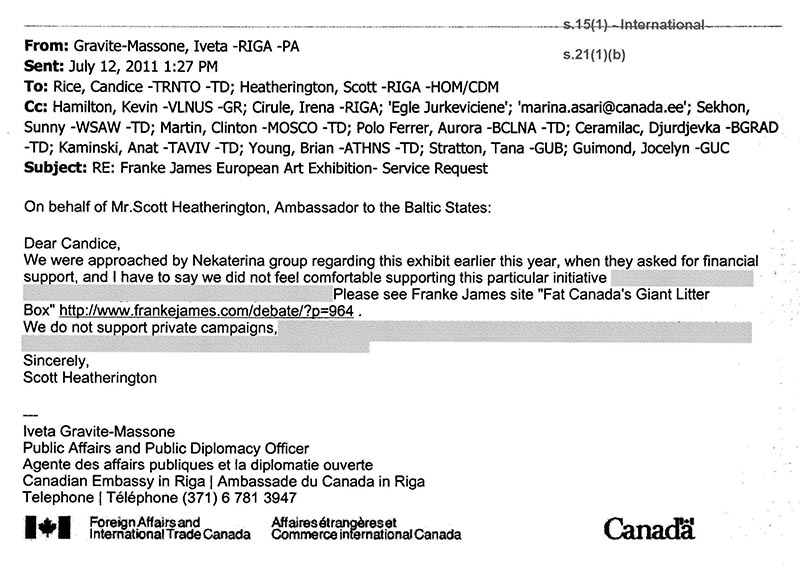
Thanks to the OIC investigation we can now see what was redacted and whether it warranted those high-level security clauses…
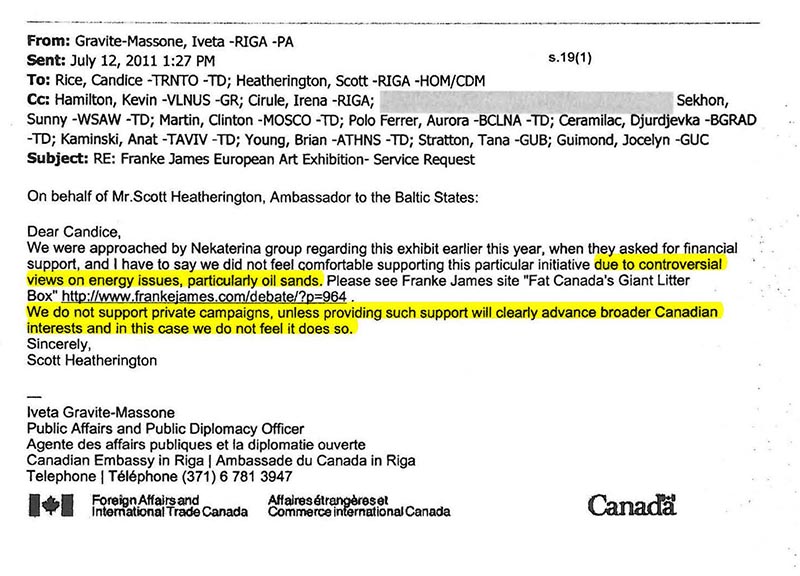 Blocked for wrong thinking: “due to controversial views on energy issues, particularly oil sands”
Blocked for wrong thinking: “due to controversial views on energy issues, particularly oil sands”
Now we can see that Ambassador Heatherington said that he won’t support my request to rent event space at his Canadian Embassy “due to controversial views on energy issues, particularly oil sands.” His statement reveals that there is a double-standard for access to Canadian Embassy services. Because my political views don’t match the current Harper government’s, then I am blocked from accessing those services. And remember this example of political interference is being hidden from view by using s.15 (1) International.
Heatherington closes by saying, “We do not support private campaigns, unless providing such support will clearly advance broader Canadian interests and in this case we do not feel it does so.” Some Canadians will nod in agreement that Canadian Embassies should not support a project which is critical of Canada’s oil sands. However this is wrong for a number of reasons.
- I asked to rent space at my own expense. Under the Charter of Rights, all Canadians are equal. Shouldn’t I have equal access to Canadian Embassies, regardless of my political views?
- Ambassador Heatherington is censoring me because my political views on the oil sands are not in agreement with the Harper government’s.
- Nektarina’s application for climate advocacy funding was approved by Sylvie Gauvin, DFAIT’s Planning, Advocacy and Innovation department. Ironically it was cancelled by the Deputy Director of Climate Change at DFAIT. (My hunch is that my show did not qualify as “Greenwash”).
- When Canada signed the UNFCCC climate agreement it pledged to support climate change education and adaptation efforts around the world. The fact that reducing greenhouse gases is in conflict with the development of the oil sands does not free them for their obligation under the UNFCCC agreement.
The Ambassador’s opinion is redacted under 21(1)(b): “We do not support private campaigns, unless providing such support will clearly advance broader Canadian interests and in this case we do not feel it does so.” I don’t know what arguments the OIC used to get the sentence unredacted however it appears that it does not qualify as advice.
In response to a media inquiry, the Ambassador’s refusal to let me rent space is quoted, but his reason is hidden
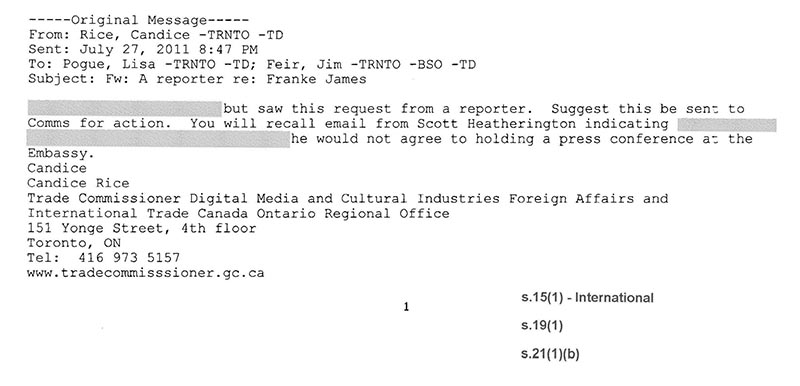
Now we can see what thought-crime is hidden under s.15(1) – “due to the artist’s views on the oilsands”
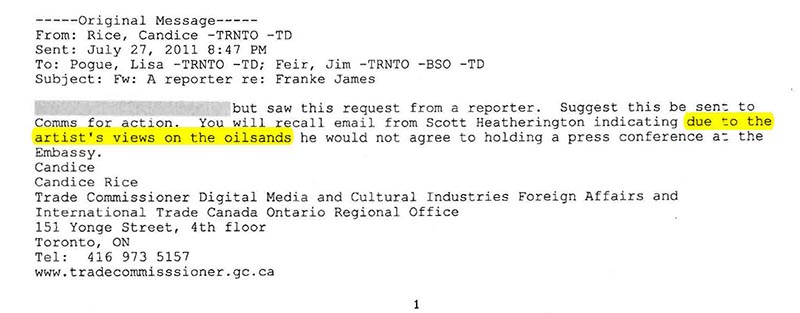
Do Not Think about Climate Change: Your views may be a threat to Canada’s security. s. 15 (1)
Ian Macleod at The Ottawa Citizen wrote about my story and quoted me, “It’s very Orwellian to see that I was being censured because of the way that I thought. They were telling me ‘do not talk about climate change.’ That is a really horrible thing for them to be doing; we need to be talking about climate change, it’s not about to disappear. We have to figure out strategies.”
Go away. Do Not Look Under This Redaction!
DFAIT is still arguing that Olivier Roy’s statement below should remain redacted under 21(1)(b).
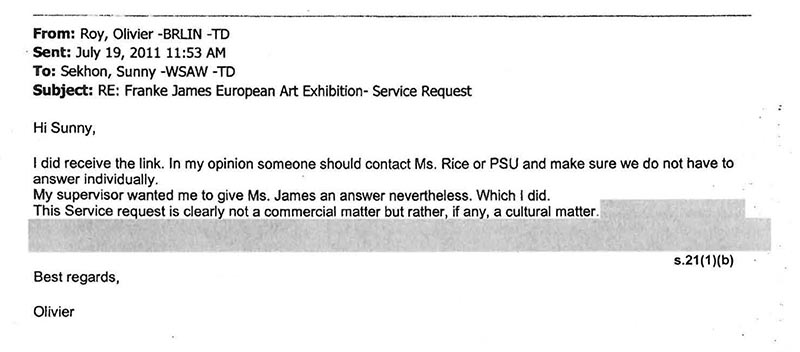
But dang! The truth slipped out: “There should never have been promises made to Ms. James of our help…”
Oh my! Somebody at DFAIT goofed. The truth slipped out under a prior access request so we can actually see that they are covering up whatever ‘stuff’ could be politically embarrassing. What will they do when Bill C-51 is passed?
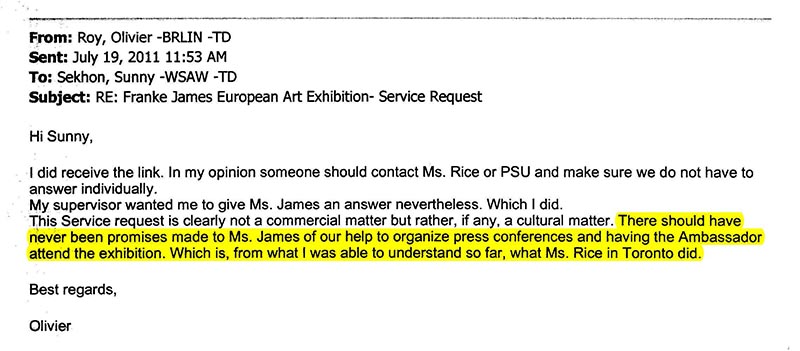
The Harper government targeted me for my “thinking” claiming that it is “injurious” to the conduct of international affairs under section 15(1)
Is the Harper government labelling anyone who questions their policies on the oil sands as ‘threats to national security’? My experience — and new evidence from an investigation by the Office of the Information Commissioner shows that to be the case. In my case, they have abused their power by misusing high-level security clauses to hide their role in bullying my supporters and stopping my privately sponsored climate change art show from happening in 2011.
Would you be afraid?
Can you imagine getting the letter below from a foreign government saying, “The reasons for this decision are not something we are able to put in writing.” Would you jump back? I wouldn’t fault you for being afraid and thinking, ‘I don’t want anything to do with that person.’ That’s the power that the government is wielding with these clauses. They can ruin reputations, and destroy careers.
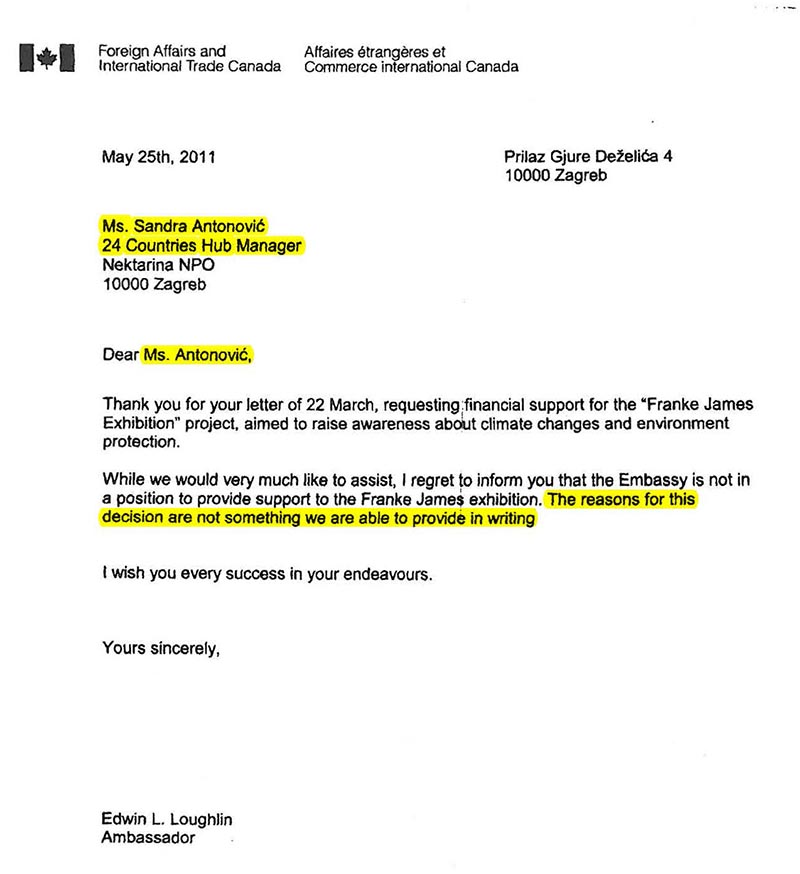
“the extremely sensitive nature of the climate change issue.”
Approval of Nektarina’s Funding and the Cancellation by the Climate Change department
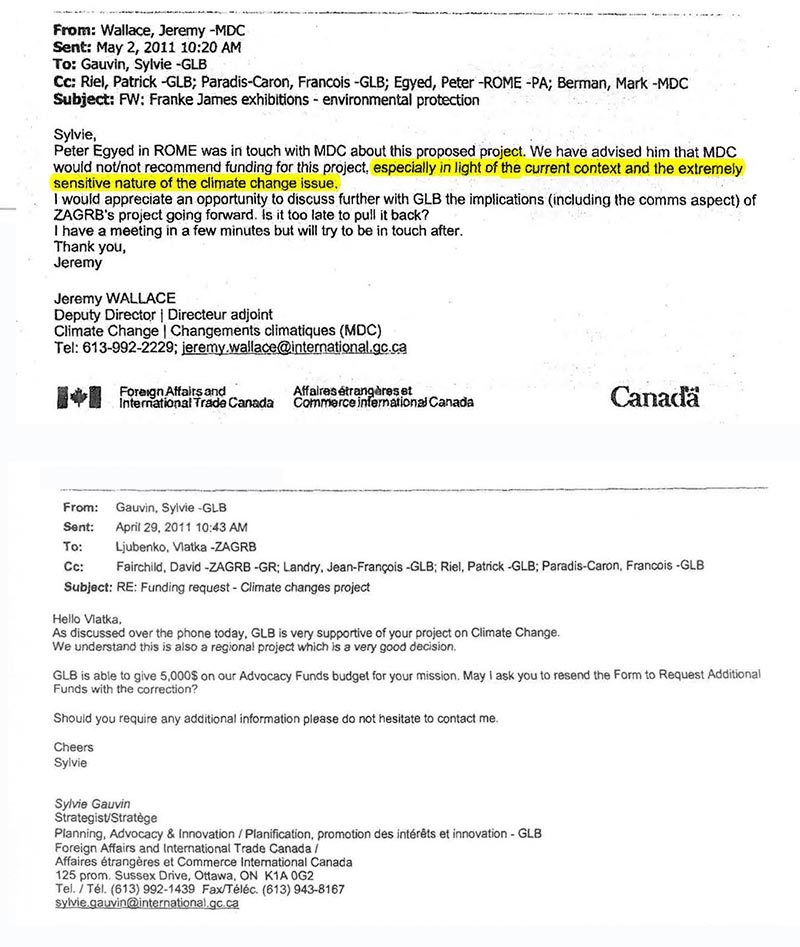 “Here we have abuse of access to information process, we have censorship, we have tyrannical information management”
“Here we have abuse of access to information process, we have censorship, we have tyrannical information management”
Kevin Walby, Associate Professor of Criminal Justice at University of Winnipeg reviewed my OIC documents and said this…
“This is a prime example of the tyrannical information management that Harper’s Conservatives engage in on every file. Access to information is one of the only means we have of holding governments accountable, and these findings show that Harper’s Conservatives are actively subverting that process.
The findings show that exemption clauses are not strictly followed and instead are applied to material simply because it does not fit into Stephen Harper’s vision of Canada. There is blatant evidence here of trying to protect the vested interest that Harper’s Conservatives have in the oilsands. The exemptions clauses are applied in ways that are a real stretch. It waters down access to information process in Canada when it is abused in these ways.
“Here we have abuse of access to information process, we have censorship, we have tyrannical information management, and all of those things are an affront to the idea of democracy, transparency and accountability. We also see that the Office of the Information Commissioner of Canada can make a difference in digging up dirt on the bad practices of government agencies.”
Why Canadians should be afraid of Bill C-51
The government’s proposed security legislation, Bill C-51 will give authorities more power to withhold information that should be publicly available. It will crush dissenting opinions. How many Canadians are going to stand up to the government if they know that the Big Brother and Secret Police Bill C-51 will let the authorities work outside of the law?
Alyssa Stryker and Carmen Cheung, rights lawyers with the BC Civil Liberties Association explained 8 things you need to know about Bill C-51
Privacy watchdog Daniel Therrien, who was blocked from appearing as a witness at the committee hearings, explained on CBC News why he is afraid of its powers to act like Big Brother, “While the potential to know virtually everything about everyone may well identify some new threats, the loss of privacy is clearly excessive,” Therrien writes. “All Canadians would be caught in this web.” He explained that bill C-51 could give “as many as 17 federal departments and agencies access to every bit of data, personal and otherwise, that any department might hold on Canadians.”
Which reminded me of the spooky feeling I had when I looked at the “cc” list on Access to Information documents regarding my cancelled art show. I was surprised when I drilled down to see who in the Canadian government was watching my file. This “Spies and Prowlers” image is from my chapter called “Games Bureaucats Play”. I realized that the eyes spanned multiple government departments from DFAIT, to Environment Canada, Transport Canada, and Public Safety.

National security expert Craig Forcese created a short primer on key aspects of Bill #C51…
Bill C-51 (Antiterrorism Act 2015)
Conservative ministers downplay concerns about terror bill
[Conservative Minister] Blaney said a new broader definition of threats to national security (which includes interference with “the economic or financial stability of Canada” or with critical infrastructure) will apply only when it comes to information-sharing provisions. Blaney said it would not be used when it comes to CSIS’s exercise of its new powers to disrupt activities of suspected threats to national security. The spy agency would use its new powers against threats to national security as they have been defined in the CSIS Act for the past 30 years, he said.
Blaney and MacKay said neither the disruption powers nor information-sharing provisions would be used against “lawful” protest, advocacy or artistic expression. MacKay said the bill “does not include lawful or unlawful protest, dissent or stoppage of work unless there is intention to cause death or serious bodily harm, endanger someone’s life, or cause risk to the safety of the public.” Toronto Star
Related Links and Media
Ian MacLeod, Ottawa Citizen, March 23, 2015:
“A British Columbia artist and environmental activist accuses government of misusing its censorship powers to hide a politically driven effort to silence her because of her views on climate change and the oilsands…”
New records detail how climate-change views scuttled artist’s grant
Justin McElroy, Global TV News, March 26, 2015
“Due to controversial views on energy issues, particularly on oil sands, the government had been wrongly applying these high level security clauses. It was to black out, redact material which was embarrassing to the government, and which was partisan,” [James] says.
Franke James letter to Suzanne Legault, OIC
“The reason I was censored should make all Canadians angry”
How Undiplomatic!
“Franke James is Your Fault?”
Scholastic Book: Censorship
Do you think a government has the right to censor an artist’s work if it makes the government look bad?
“What can one person do?” (pdf) proposed European art show in 2011, curated by Nektarina Non Profit.
Nektarina Proposal to Canadian Embassy in Croatia. Source – ATIP_A201100802
Media Campaign: Crowdfunding Puts Do Not Talk Posters Up in Ottawa, Calgary and Halifax.
Banned on the Hill’s Indiegogo Updates 2013- 2014
Book 2013: Banned on the Hill: a true story about dirty oil and government censorship.
Video 2011: Banned on the Hill (and in Europe!)
Art show 2011: Victory! Banned on the Hill Opening in Ottawa
Press release: PEN Canada and the Writers’ Union of Canada (TWUC) issued a press release, expressing concern over Government interference: “The government of Canada has no right to determine what is an acceptable opinion for an individual citizen, on climate change or any matter of public interest,” said Charlie Foran, President of PEN Canada, “To do so is clearly not in the spirit of the Charter and the long history of freedom of expression in Canada.”
Like this:
Like Loading...


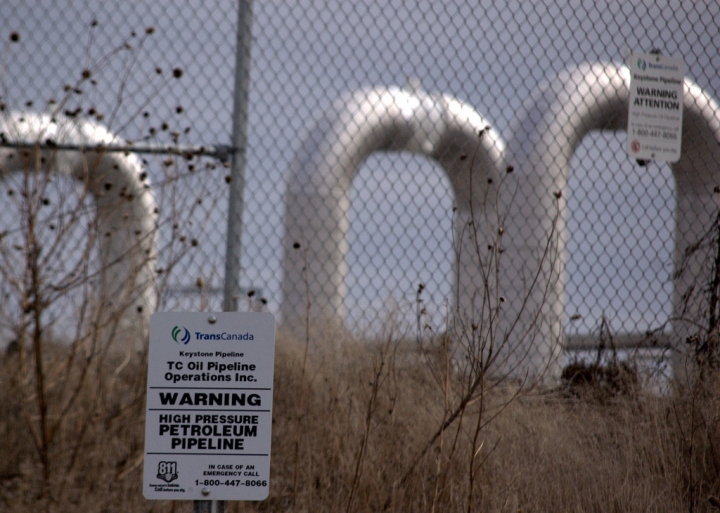
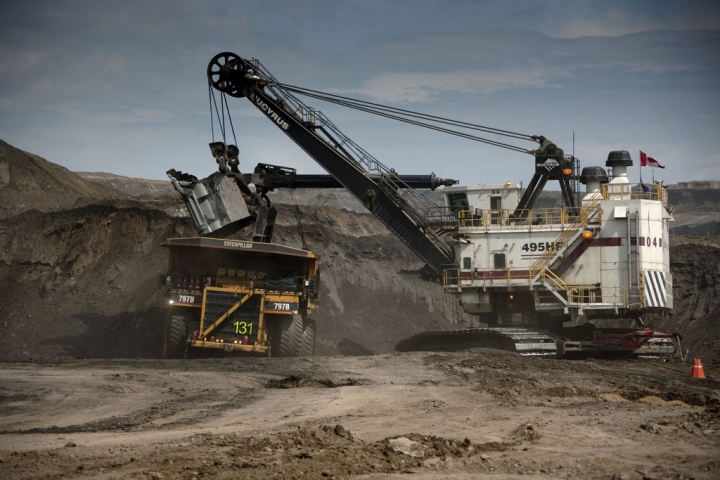

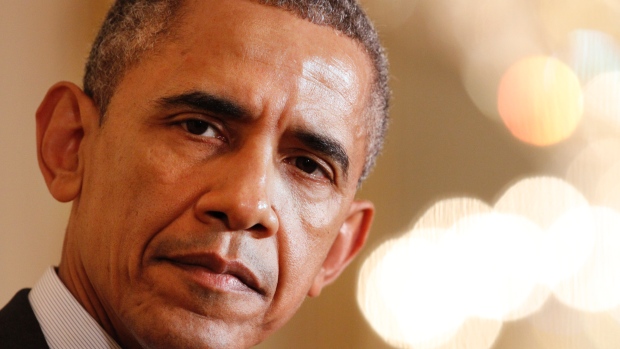











 “Here we have abuse of access to information process, we have censorship, we have tyrannical information management”
“Here we have abuse of access to information process, we have censorship, we have tyrannical information management”